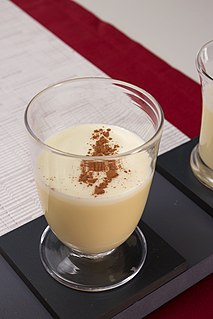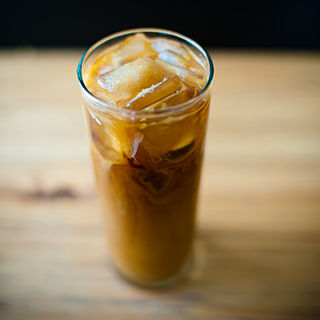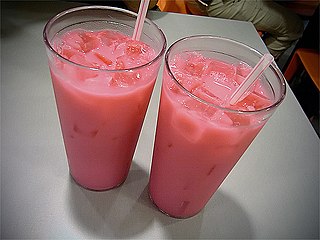
Bubbletea is a Taiwanese tea-based drink invented in Tainan and Taichung in the 1980s. Recipes contain tea of some kind, flavors of milk, as well as sugar (optional). Toppings, such as chewy tapioca balls, popping boba, fruit jelly, grass jelly, agar jelly, and puddings are often added. Ice-blended versions are frozen and put into a blender, resulting in a slushy consistency. There are many varieties of the drink with a wide range of flavors. The two most popular varieties are black pearl milk tea and green pearl milk tea. "Boba" is Cantonese slang for "king of breasts" referring to the tapioca balls.

Mojito is a traditional Cuban highball.

In cooking, a syrup or sirup is a condiment that is a thick, viscous liquid consisting primarily of a solution of sugar in water, containing a large amount of dissolved sugars but showing little tendency to deposit crystals. Its consistency is similar to that of molasses. The viscosity arises from the multiple hydrogen bonds between the dissolved sugar, which has many hydroxyl (OH) groups, anSyrup can be made by dissolving sugar in water or by reducing naturally sweet juices such as cane

Amazake is a traditional sweet, low-alcohol Japanese drink made from fermented rice. Amazake dates from the Kofun period, and it is mentioned in the Nihon Shoki. It is part of the family of traditional Japanese foods made using koji and the koji mold Aspergillus oryzae that includes miso, soy sauce, and sake.

Eggnog, egg nog or egg-nog, historically also known as milk punch or egg milk punch, is a rich, chilled, sweetened, dairy-based beverage. It is traditionally made with milk, cream, sugar, whipped egg whites, and egg yolks. In some contexts, distilled spirits such as brandy, rum, whisky or bourbon are added to the drink.

Coffee milk is a drink made by mixing coffee syrup or coffee extract and milk together in a manner similar to chocolate milk. It is the official state drink in Rhode Island.

Jalebi, also known as zulbia and zalabia, is a sweet popular food in some parts of the Indian subcontinent, West Asia, North Africa, and East Africa. It is made by deep-frying maida flour batter in pretzel or circular shapes, which are then soaked in sugar syrup. They are particularly popular in the Indian subcontinent and Iran.

Iced coffee is a type of coffee beverage served chilled, brewed variously with the fundamental division being cold brew – brewing the coffee cold, yielding a different flavor, and not requiring cooling – or brewing normally (hot) and then cooling, generally by simply pouring over ice or into ice cold milk. In hot brewing, sweeteners and flavorings are often mixed into the hot coffee before cooling, due to faster dissolution in hot water. Alternatively, syrup may be used, particularly gum syrup.

Falooda is a cold dessert with origins in the Indian subcontinent. Traditionally it is made from mixing rose syrup, vermicelli, sweet basil (sabza/takmaria) seeds with milk, often served with ice cream. The vermicelli used for preparing falooda is made from wheat, arrowroot, cornstarch, or sago.

Switchel, also switzel, swizzle, ginger-water, haymaker's punch or switchy, is a drink made of water mixed with vinegar, and often seasoned with ginger. Though usually sweetened with molasses, honey, sugar, brown sugar, or maple syrup were sometimes used instead. In the U.S. state of Vermont, oatmeal and lemon juice were sometimes added to the beverage.

Grass jelly, or leaf jelly, is a jelly-like dessert eaten in Mainland China, Hong Kong, Macau, Southeast Asia, and Taiwan. It is made using the Platostoma palustre plant and has a mild, slightly bitter taste. It is served chilled, with other toppings such as fruit, or in bubble tea or other drinks. Outside Asia, it is sold in Asian supermarkets.

Bandung, sirap bandung, or air bandung is a drink popular in India, Malaysia, Singapore and Brunei. It consists of evaporated milk or condensed milk flavoured with rose cordial syrup, giving it a pink colour. The drink is an adaptation of rose milk served in India.

Cendol is an iced sweet dessert that contains droplets of worm-like green rice flour jelly, coconut milk and palm sugar syrup. It is commonly found in Southeast Asia and is popular in Indonesia, Malaysia, Singapore, Brunei, Cambodia, East Timor, Vietnam, Thailand, and Burma. Next to the green jelly, additional toppings might be added, including diced jackfruit, sweetened red azuki beans, or durian.

Sorbet is a frozen dessert made from sweetened water with flavoring.
Drink mixers are the non-alcoholic ingredients in mixed drinks and cocktails. There are many reasons mixers are used. They change or enhance flavors or add new ones to a drink. Mixers dilute the drink, lowering the alcohol by volume in the drink. They may make the drink sweeter, more sour, or more savory. Some mixers change the texture or consistency of the drink, making it thicker or more watery. Drink mixers may also be used strictly for decorative purposes by changing the color or appearance of the drink.They also simply increase the volume of a drink, to make it last longer.

In terms of mixed drinks, shrub is the name of two different, but related, acidulated beverages. One type of shrub is a fruit liqueur that was popular in 17th and 18th century England, typically made with rum or brandy mixed with sugar and the juice or rinds of citrus fruit.

Masala chai is a flavoured tea beverage made by brewing black tea with a mixture of aromatic spices and herbs. Originating in the Indian subcontinent, the beverage has gained worldwide popularity, becoming a feature in many coffee and tea houses. Although traditionally prepared as a decoction of green cardamom pods, cinnamon sticks, ground cloves, ground ginger, and black peppercorn together with black tea leaves, retail versions include tea bags for infusion, instant powdered mixtures, and concentrates.

Sharbat, shorbot or sherbet is a popular West Asian and Indian subcontinental drink prepared from fruits or flower petals. It is sweet and usually served chilled. It can be served in concentrate form and eaten with a spoon or diluted with water to create the drink.




















